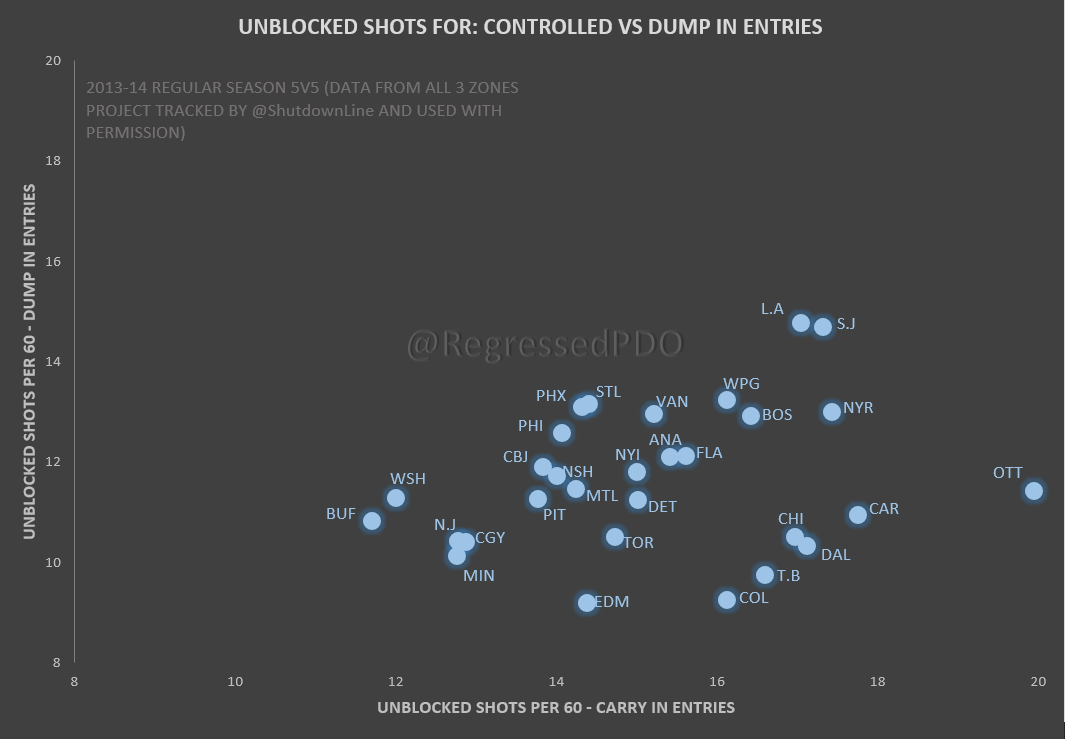So you'd have people believe that putting a puck past an NHL goalie is as easy as making a pass up ice, a shot on net, a stick-check, a body-check, etc. ?
No, I'm saying that there are a ton of (more reliable) variables that result in goals/goals against.
What is it about goal scoring exactly, that turns you off?
Nothing. A positive goal differential is the ideal result (it should be the goal, no pun intended), I just don't think looking at past goal-based results are an indication of future goal results.
Let me ask you, you are aware that the game of hockey is decided through goal-scoring?
And goal prevention.
My classification of scoring chances accounts for a whole host of factors, not the least of which can be encapsulated in some silly little "one-size-fits-all" statistic that you and others think describes the ease or difficulty of the shot.
Here's the thing: I (and many others) don't believe there's a 'one-size-fits-all' metric. If we did, we'd be preaching goal metrics.
I gave you examples of how your silly little "scoring chance" charts fails when real-world conditions and applications are applied to it... (i.e. point shots , screens, passing plays, and of course velocity and placement)
My silly little 'scoring chance' chart? First of all, those locations are substantiated by, y'know, results, so your complete dismal of them is laughable at best, and moronic at worst. Secondly, I referenced statistics/studies that account for rush shots (proven to result in more goals), deflections (more difficult to save, but account for a small percentage of 'shots'), rebound shots (proven to result in more goals), scramble shots (proven) and pre-shot movement (passing; proven to result in more goals/difficultly of saves is increased).
I applaud you for summarizing where shots come from and how many of them scored but that has no correlation to the next shot from that area's ease or difficulty.
It has a correlation with its likelihood of entering the net, though.
Wonderful but I have a feeling the team with the best goal-differential just might have an easier time winning games.
Yeah, but the better team doesn't always win; that's the problem with goal metrics.
This is just rooted in an understanding of how games are won: outscoring the opponent.
The object of the game isn't to play keep-away.
Sure, the object of the game is to outscore your opponents, but 'keep-away'
is a way to do that.
You get goals by getting scoring chances. You get scoring chances by taking shots. You take shots by possessing the puck in the offensive zone.
There's a sequence of events that need to take place for a goal to happen.
And yet you're using the metric that has such a high unexplained variance that it's an outright awful statistic when using it to measure the abilities of a team/player in small (anything less than 5 years for goals) samples.
You do understand that a statistic must be both accurate (valid) and precise (reliable) for it to be legitimately useable (indicative), don't you?
The last possible one that does is a scoring chance.
Not a zone exit. Not a zone entry. Not even just a shot.
Scoring chances.
And you need a zone-entry, a zone-exit, a loose-puck recovery, a shot, a successful deke etc (or some combination of all of the above) to get to a scoring chance/goal (and that happen at a far higher rate than either scoring chances/goals).
It's entirely possible for a player to score at a very high rate (or put up a great goal differential) one year, and then hardly score the next season; it's because goals aren't reliable.
This is the missing link in your data and it is not a quantitative measure.
It is a qualitative measure.
Yeah, but it's not... at all.
You can qualify what events result in a higher 'percentage' of goals.
Again, there is simply no way for a computer to intelligently measure the quality of a scoring chance.
Measure the area a shot was taken tells you nothing about how easy or hard it was for the goalie to save.
SportLogIQ can measure far more than 'where the shot was taken'. They can measure screens, deflections, rebounds... everything you claim to be important when determining a scoring chance (but have yet to prove).



